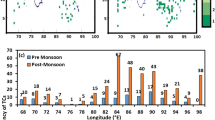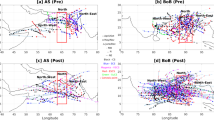Abstract
The North Indian Ocean (NIO) which accounts for about 5% of total global tropical cyclones produces about four TCs per year out of which three form in the Bay of Bengal (BOB) and one forms in the Arabian Sea (AS). Because of various socioeconomic factors, these cyclones inflict heavy loss of life and property in the NIO rim countries. Utilizing reliable dataset of satellite era, it has been shown that the stronger TCs with maximum sustained winds (MSW) exceeding 95 nautical miles per hour (knots) and above have become more frequent in the NIO during the past 3 decades. When the frequency of all TCs with MSW exceeding 63 knots is considered, the uptrend reduces. Thus, an increase in the frequency of stronger TCs in NIO during the past few decades is a reality. Extensive work has been done on the changes in the frequency and intensity of TCs of North Indian Ocean (Bay of Bengal and Arabian Sea) by Indian meteorologists (Mooley 1980, 1981; Singh et al. 2000, 2001; Singh 2007; Srivastav et al. 2000). There has been certain amount of ambiguity about the reliability of TC data before the satellite detection of TCs which commenced in the 1970s. For the NIO, the satellite detection of TCs started in 1972 by the Joint Typhoon Warning Centre (JTWC), Guam (now shifted to Pearl Harbor, Hawaii), USA. The India Meteorological Department (IMD) started the satellite detection of TCs from the early 1980s onward when the Indian geostationary satellite, INSAT was launched. The JTWC data on TCs of NIO for 1972-2006 have been used in the present work. Utilizing IMDs existing dataset, a few earlier works (Singh et al. 2001; Singh 2007; Srivastav et al. 2000) have shown that there is an uptrend in the frequency of intense TCs in NIO during the months of high TC activity, i.e., November and May. In the present study, an attempt has been made to derive firm conclusions on recent trends in the annual number of stronger TCs in NIO removing the ambiguity of data of presatellite era.
Access provided by Autonomous University of Puebla. Download chapter PDF
Similar content being viewed by others
Keywords
Introduction
The North Indian Ocean (NIO) which accounts for about 5% of total global tropical cyclones produces about four TCs per year out of which three form in the Bay of Bengal (BOB) and one forms in the Arabian Sea (AS). Because of various socioeconomic factors, these cyclones inflict heavy loss of life and property in the NIO rim countries. Utilizing reliable dataset of satellite era, it has been shown that the stronger TCs with maximum sustained winds (MSW) exceeding 95 nautical miles per hour (knots) and above have become more frequent in the NIO during the past 3 decades. When the frequency of all TCs with MSW exceeding 63 knots is considered, the uptrend reduces. Thus, an increase in the frequency of stronger TCs in NIO during the past few decades is a reality. Extensive work has been done on the changes in the frequency and intensity of TCs of North Indian Ocean (Bay of Bengal and Arabian Sea) by Indian meteorologists (Mooley 1980, 1981; Singh et al. 2000, 2001; Singh 2007; Srivastav et al. 2000). There has been certain amount of ambiguity about the reliability of TC data before the satellite detection of TCs which commenced in the 1970s. For the NIO, the satellite detection of TCs started in 1972 by the Joint Typhoon Warning Centre (JTWC), Guam (now shifted to Pearl Harbor, Hawaii), USA. The India Meteorological Department (IMD) started the satellite detection of TCs from the early 1980s onward when the Indian geostationary satellite, INSAT was launched. The JTWC data on TCs of NIO for 1972-2006 have been used in the present work. Utilizing IMDs existing dataset, a few earlier works (Singh et al. 2001; Singh 2007; Srivastav et al. 2000) have shown that there is an uptrend in the frequency of intense TCs in NIO during the months of high TC activity, i.e., November and May. In the present study, an attempt has been made to derive firm conclusions on recent trends in the annual number of stronger TCs in NIO removing the ambiguity of data of presatellite era.
Results and Discussion
Trends in the Frequency of Stronger TCs (Maximum Sustained Wind [MSW] 96 knots and Above)
In Fig. 1, the frequency of stronger TCs in NIO for the 3 decades; 1972-81, 1982-91, and 1992-2001 has been shown. Only two stronger TCs formed in the NIO (Bay of Bengal and Arabian Sea) during 1972-1981. The frequency increased to 4 and 9 stronger TCs in the next 2 decades, respectively. The implications of this increase in stronger TC number in the NIO may be enormous for the NIO rim countries like Bangladesh, India, Myanmar, Sri Lanka, and even Pakistan and Oman. The observed trend in the frequency of stronger TCs with NIO during past decades shows that on an average the rim countries have to face about one TC of category 3 and above every year. The situation 3 decades ago was one TC of category 3 and above every 5 years. Thus, there is a fivefold increase in the occurrence of a stronger TC in NIO. Table 1 summarizes all 15 cases of stronger TCs that occurred in the NIO during the 3 decades period from 1972 to 2001.
Simulation Experiments
In order to simulate the impacts of global climate change (due to increased anthropogenic emissions) on the cyclogenesis in the Bay of Bengal, two experiments, namely one with fixed amount of greenhouse-gas concentration corresponding to 1990 levels called the “control” (CTL), and the other with annual compound increase of 1% in the greenhouse-gas concentration for 2041-2060 from 1990 onward called the “greenhouse gas” (GHG) were conducted. The annual compound increment of 1% in the greenhouse-gas concentration has been adopted from the projections of Intergovernmental Panel for Climate Change (IPCC). The model used was HadRM2 of Hadley Centre for Climate Prediction and Research, UK. The horizontal resolution of the model is 0.44° × 0.44°, i.e., minimum resolution of 50 × 50 km at the equator. The criteria adopted for the identification of storms, in addition to a local minimum in sea-level pressure, was as follows: (i) Sea-level pressure departure <−5 hPa, (ii) Maximum wind speed >15 m/s, and (iii) Duration of the storm of at least 2 days. It may be pointed out that all storms (vortices) could be easily identified in the simulations.
Simulation of Intensity
The results on intensity simulations for May, October, and November are presented in Fig. 2. During all the 3 months the model has simulated an enhancement in the average maximum wind speed of the storms. In October the average wind speed has gone up from 42 kts in CTL to 48 knots in GHG and in November it has gone up from 52 knots in CTL to 60 kts in GHG. Thus during both intense cyclone months the intensity has increased and the average cyclone during these months will be a severe cyclone (maximum wind speed more or equal to 48 knots), which is not the case at present during October. Similarly, during May also the average intensity has increased slightly in GHG as compared to CTL. Thus the model has simulated an increase in the average maximum wind speed of cyclones forming during May, October, and November.
References
Mooley DA (1980) Severe cyclonic storms in the Bay of Bengal, 1877-1977. Mon Wea Rev 108:1647-1655
Mooley DA (1981) Increase in the frequency of the severe cyclonic storms of the Bay after 1964 - Possible causes. Mausam 32:35-40
Singh OP (2007) Long-term trends in the frequency of severe cyclones of Bay of Bengal: observations and simulations. Mausam 58:59-66
Singh OP, Khan TMA, Rahman S (2000) Changes in the frequency of tropical cyclones over the North Indian Ocean. Meteorol Atmos Phys 75:11-20
Singh OP, Khan TMA, Rahman S (2001) Has the frequency of intense tropical cyclones increased in the North Indian Ocean? Curr Sci 80:575-580
Srivastav AK, Sinha Ray KC, De US (2000) Trends in the frequency of cyclonic disturbances and their intensification over Indian Seas. Mausam 51:113-118
Author information
Authors and Affiliations
Editor information
Editors and Affiliations
Rights and permissions
Copyright information
© 2010 Springer Science+Business Media B.V.
About this chapter
Cite this chapter
Singh, O.P. (2010). Recent Trends in Tropical Cyclone Activity in the North Indian Ocean. In: Charabi, Y. (eds) Indian Ocean Tropical Cyclones and Climate Change. Springer, Dordrecht. https://doi.org/10.1007/978-90-481-3109-9_8
Download citation
DOI: https://doi.org/10.1007/978-90-481-3109-9_8
Published:
Publisher Name: Springer, Dordrecht
Print ISBN: 978-90-481-3108-2
Online ISBN: 978-90-481-3109-9
eBook Packages: Earth and Environmental ScienceEarth and Environmental Science (R0)






